Writing optimized blog posts for both search engines and users is a skill. And like any other skill, it can be improved by practice.
Despite what many people think, it’s not a complicated process. There are some simple steps to follow to ensure that everything you publish on your website or blog is SEO friendly.
Things like the title of the post, the structure of a blog, text formatting, headings, and paragraphs are easy to fix and yet play a vital role in rankings.
In this post you’ll learn about the 10 Step Process I follow to SEO optimize all my blog posts.
Before getting into the details, it is necessary to clarify two things that a lot of people find confusing.
First, an SEO friendly blog post is also a user-friendly blog post
Many people believe that if a blog post is optimized for search engines, it is somehow less friendly for the users. This is not true.
The true meaning of SEO is to publish content that both search engines and users can understand.
If both of these conditions are not met, then you have limited chances of achieving high rankings, and your readers are more likely to ‘ignore’ your post.
If, on the other hand, you manage to meet both criteria, then your blog posts will rank higher on Google, and users will spend more time reading and engaging with your content (adding comments, sharing to social media, or converting).
Second, a post that is SEO optimized does not necessarily have great content
This may sound like a contradicting statement, but it’s not. Let me explain.
The quality of the content is one of the most important factors when evaluating a blog post, but it’s not the only one.
A well-optimized blog post with great quality content has more chances of ranking higher in search while a well-optimized blog post with not so good content has limited chances of achieving high Google rankings.
In other words, you shouldn’t expect a blog post to rank high just because you followed the steps to make it SEO-friendly.
It’s the combination of good content and good SEO (including Off-Page SEO) that will push a blog post to the first pages of Google.
So, now that you have a better understanding of what is an optimized blog post and what is not, let’s see how to ensure (before you hit the publish button), that your blog will be SEO friendly.
10 Tips for Writing SEO Friendly Blog Posts
- Think before you start writing
- Create the structure of the blog post
- Craft the title and URL
- Use headings correctly
- Keep your paragraphs short
- Add links when it makes sense
- Do make use of keywords (but not keyword stuffing)
- Optimize the length of your blog post
- Optimize your meta description
- Optimize your images and other media elements
1. Think before you start writing
Any time you spend in the beginning thinking about what to write in your blog post, it’s time that you will save later in the process.
This is what I do:
On a daily basis, I read a number of articles related to SEO and marketing from various digital marketing blogs.
When I find a title or topic that is interesting and a candidate for one of my future blogs, I copy the URL and title to my notes.
At the beginning of each month, I create my publishing schedule. Among other sources, I also look into my notes and review all saved articles.
After I decide which topics to cover, I set a publishing date for each topic in a Google calendar.
When it’s time actually to write the post, I take the topic and do a more detailed analysis (including keyword research) to answer these questions:
- What specific topics to cover in the blog post?
- What is the goal of the post (to get better rankings for a keyword, to get more subscribers, to promote my SEO Courses, etc.)
- How will the new post benefit my readers?
Answering these questions in advance makes it easier to move on to the next steps.
2. Create the structure of the blog post
The next step is to write down the structure of your blog post. By structure, I mean to define the different parts of the post.
Splitting a blog post into various parts can make writing easier. It’s faster and more efficient to write 200 words to cover a specific part of the post, rather than trying to write larger sections.
HINT: This is particularly useful when you don’t have the time to finish the post in one sitting. Once you have the structure ready, you can work on the different parts independently of each other without needing a lot of time to re-generate your focus and organize your thoughts.
For example, before writing the blog post you are reading now, I created the structure which looked like this:
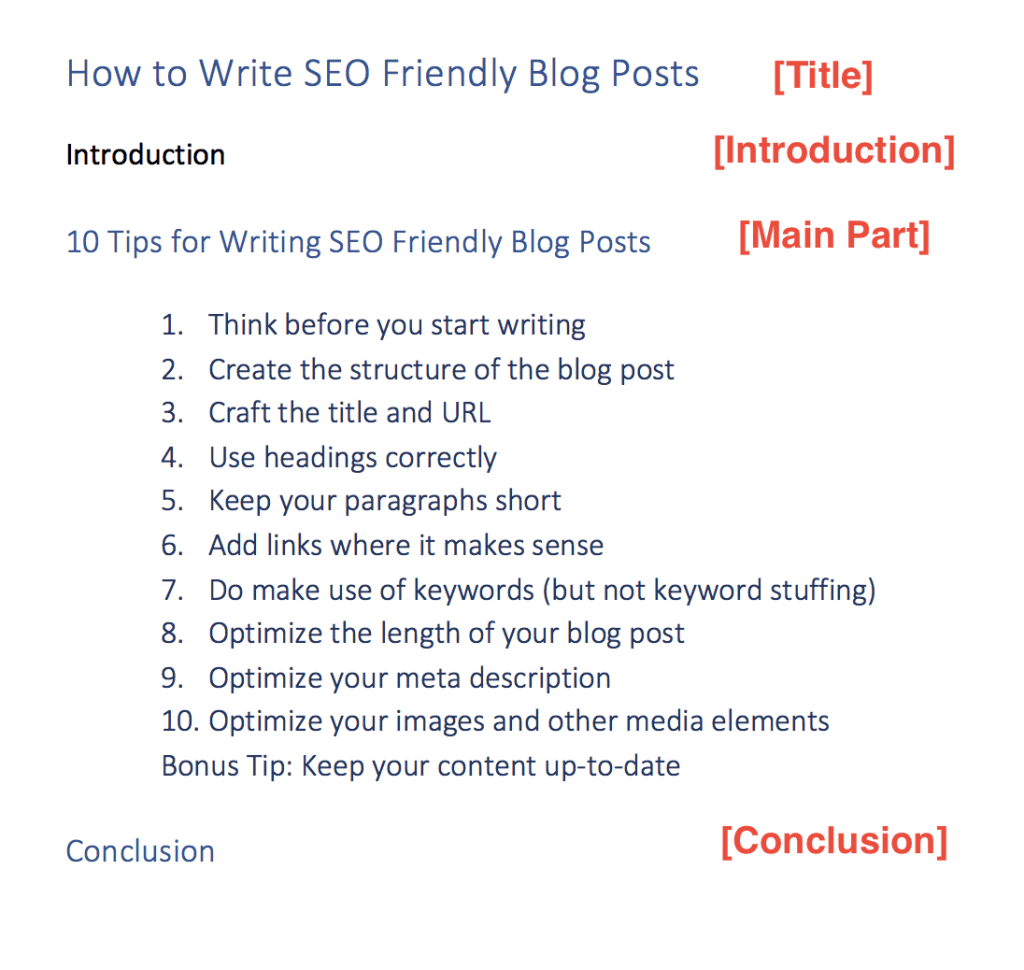
In general, a blog post should have an introduction, main part, and conclusion (similar to writing an essay).
The main section can then be broken down into a number of parts. Look at the structure of this post again and scroll up and down the page to see the end result.
Notice how I divided the main section of the post (10 Tips for Writing SEO Friendly Blog Post) into different parts.
3. Craft the title and URL
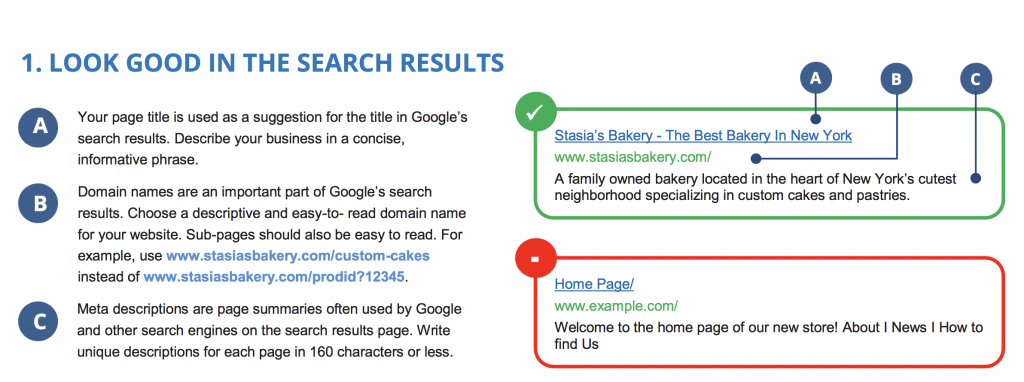
The next step is to decide about the title of your blog post and the URL.
I know that some bloggers prefer to do this step first and then create the blog structure, but I found that it’s easier to come up with the title once you have a good idea of what the post will cover.
If you feel that you need to work on the title first and then the blog structure, then, by all means, follow what is more efficient for your case.
Writing a good and interesting title is a very important step for SEO purposes and user-friendliness.
An optimized title is important for SEO because it gives Search Engines a big hint on what the page is about.
A good title should have the following characteristics:
- It has a character length between 55-60 so that it is shown without breaks in the SERPS.
- It includes your target keyword (but not keyword-stuffed)
- It accurately describes the content of the blog post
- It is interesting to make users click your entry when displayed in the search engine results pages.
Take for example the title of this post “How to Write SEO Friendly Blog Posts – My Step by Step Process”.
My target keyword was “SEO friendly blog posts” and instead of just creating a title with that keyword alone, I added the ‘How to’ and the ‘My step by step process”, to make it clear to both search engines and users of what to expect in the content.
There is a list of power words, proven by research that makes titles more interesting and clickable.
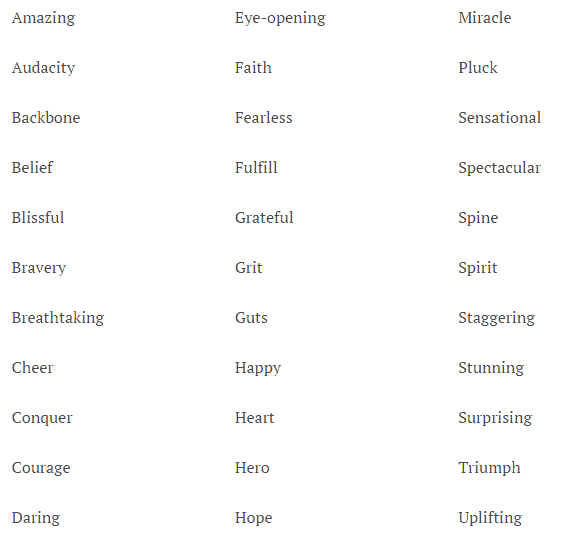
Other nice examples of optimized titles are shown in the screenshots below:
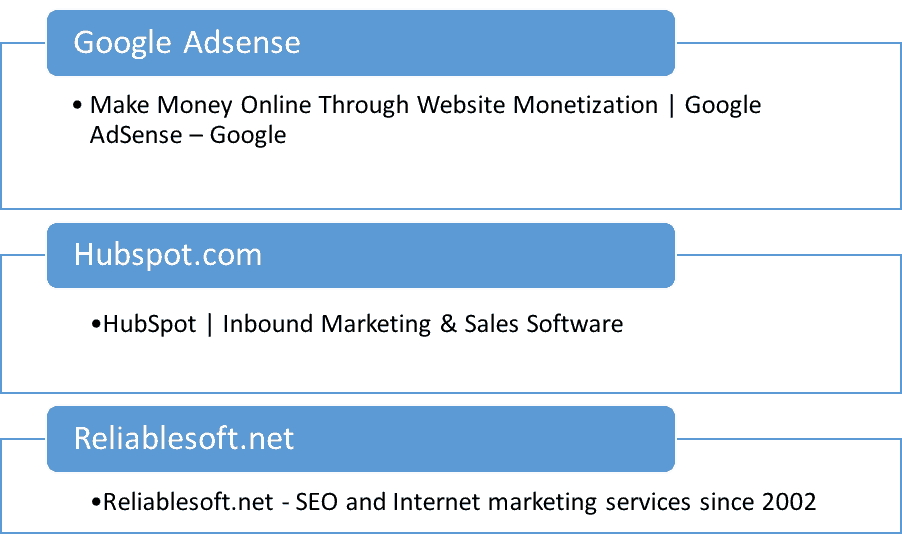
When it comes to the URL, the rules are simple:
- Use “-“ to separate the words that make up a URL. If this is not the case for your blog and you are on WordPress, you need to change your permalink structure.
- Consider making your URLs shorter by removing unnecessary words – Usually what happens is that the URL is auto-generated by your CMS based on the title. What you can do (before publishing a blog post the first time) is to manually change the permalink (URL) and remove some of the words.
For example, the default URL for this blog post was /how-to-write-SEO-friendly-blog-posts –my-step-by-step-process/ but I have optimized it by changing it to /seo-friendly-blog-posts/.
There are some studies to confirm this but as noted many times by Google, your URL format alone is not a big ranking factor.
Important: If you want to change your URL after a post is published, you need to add 301 redirects to preserve your rankings.
Resources to learn more
- SEO Best Practices – Rules to follow to SEO optimize your blog posts.
- SEO Friendly URLs – How to create URLs that are search engine friendly.
4. Use headings correctly
A well-optimized blog post follows these rules when it comes to headings:
There is only one h1 tag on the page – Which is usually the same as the <title> of the post, although it doesn’t have to be the same.
What is important is to have only one h1 tag and that heading to include your target keywords.
Use headings in a hierarchical mode: The title of the post is the h1 tag and then the main sections should have an h2 and the subsections an h3.
So, the order of the tags should be H1->H2->H3.
When you create a good blog structure, then it’s easy to get the headings right. Take a look at the screenshot below which shows how I used headings for this blog post.
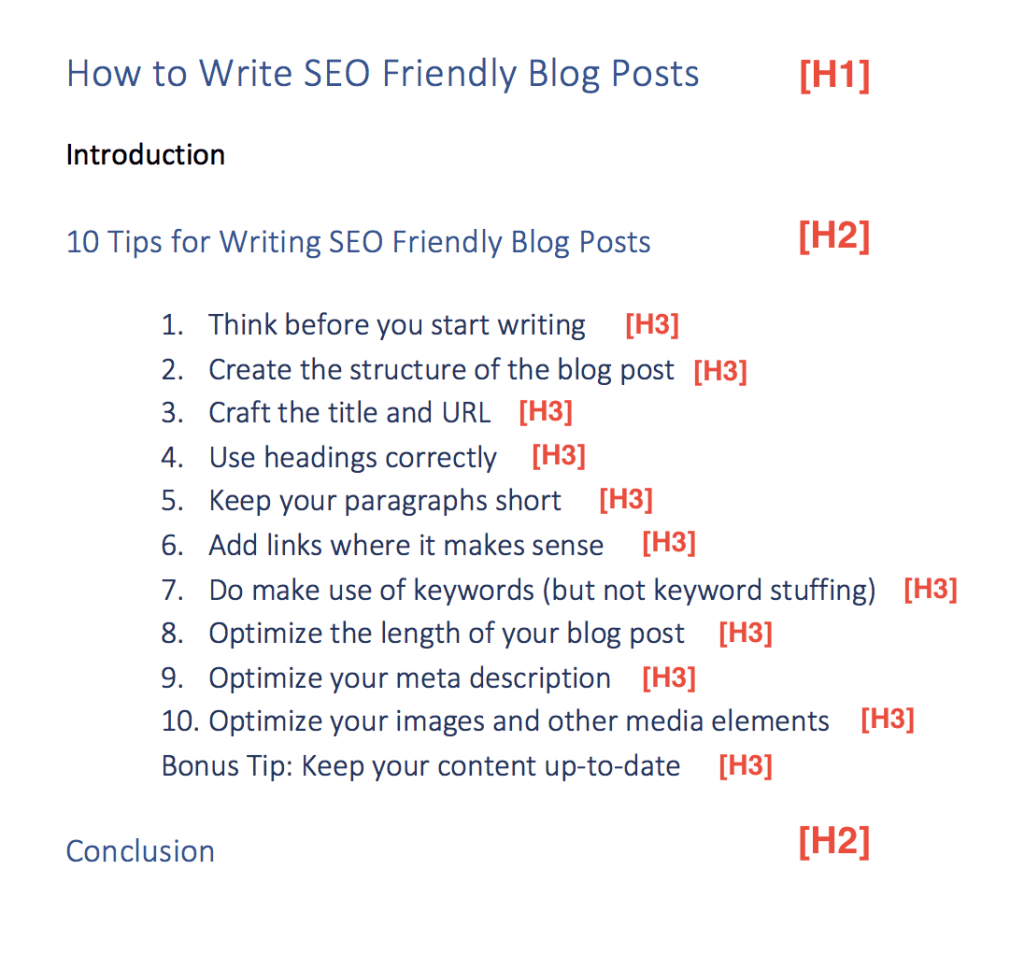
The reason that you should have your content organized in this structural way is simple: It helps search engine spiders during the crawling process and makes the blog post easier to read (and scan) for users.
Resources to learn more
- H1 Tag – Everything you need to know about H1 tags and headings.
- Page title Vs H1 Tag – Different between a title and an H1 Tag for SEO.
5. Keep your paragraphs short
Don’t just throw large paragraphs on a page and hit the publish button.
There is a good possibility that the majority of your readers are on mobile so make it easy for them to read the content.
Use small paragraphs (2-3 sentences long) and take advantage of the various formatting options i.e. bold, italic, underline to make the text less boring.
6. Add links when it makes sense
Whenever you write a new piece, try to ‘associate it’ with already published blog posts on your blog, by adding internal links.
Internal linking is a very effective and easy to follow SEO technique that has a number of benefits:
- It helps search engines discover new pages on your website – when crawling a page, search engine spiders will follow any link (that doesn’t have the nofollow attribute) and add it to their index (if it does not exist).
- It’s another way to give search engines a big hint on what a page is about – for example, when I add a link like this: SEO Tutorial, I’m telling the crawler what the linking page has to do with SEO tutorials.
- It’s a great way to give users an option to click a link and read more about a topic.
- It’s one of the techniques you can use to reduce the bounce rate and keep users on your website for more time.
Take a closer look at this post and notice how I added links to other posts.
Don’t be afraid to use keywords in the anchor text, there is no penalty for doing so.
Google is doing it in their blogs and so does Wikipedia (see screenshot below).
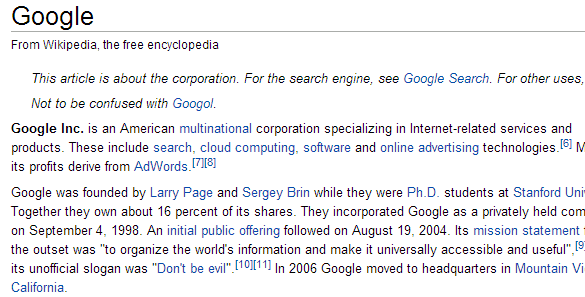
7. Do make use of keywords (but not keyword stuffing)
Having your target keywords (and variations) in your blog posts will not get you into trouble, in fact, it is recommended to do so.
As I mentioned at the beginning of this post, what is not recommended is keyword stuffing.
In other words, don’t add keywords in the text for the sake of doing so but do it only when it’s natural to read.
Where should you add keywords? I get this question a lot and the answer is simple:
- In the title of the post
- In the main headings of your post
- Within the context of the post
- In the ‘conclusion’
Here is a hint for you
To avoid keyword stuffing and repeating the same keyword over and over again, go to the Google Keyword Tool or SEMRUSH and search for your main keyword.
These tools will give you a list of keywords that are closely related to your main keyword. Make sure that you mention some of those keywords in your blog post.
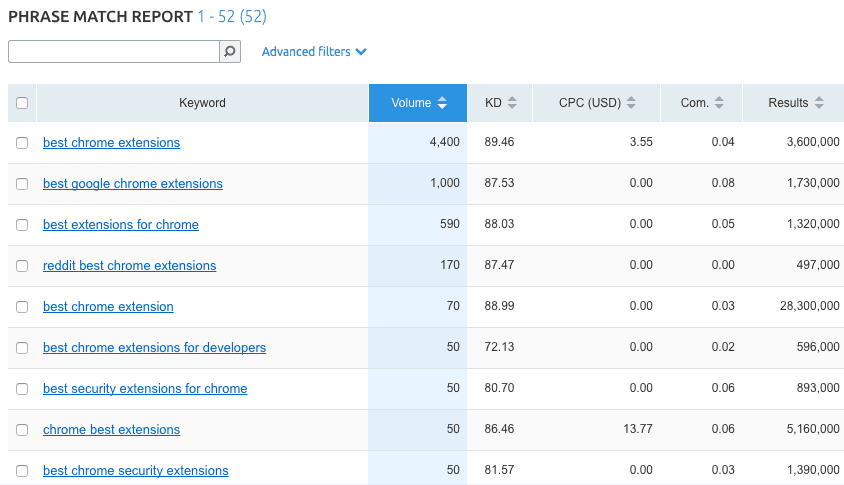
8. Optimize the length of your blog post
Studies have shown that longer posts perform better in search and they tend to receive more likes and mentions on social media.
While this is true, it does not mean that shorter posts will not rank well. What is more important is the quality of the content and not the quantity.
You should understand that when writing a blog post for a particular topic, you are in essence competing with hundreds of other posts that are already published about the same topic.
Your goal is to make your blog posts better so that when promoted correctly, it will attract the attention of users and possibly natural links so that eventually they can outrank the existing posts.
When Google is evaluating the ranking of a page, it does not take into account the number of words, but the number of links pointing to that page.
Promoting an in-depth post that covers both sides of a story, with nice images, references to studies and useful information is much more likely to get links compared to a post that is short and not so interesting.
The best way to find out how long to make your blog posts is to open Google, search for your target keywords, and examine the results.
Open all ten entries that appear on the first page and take note of the number of words and types of content they provide.
Aim to publish a piece that is better in all aspects (word length, formatting, quality of information).
Hit the publish button and then use all available white hat methods to drive traffic to your blog.
Don’t expect to get results immediately, it takes time to rank in Google so don’t just sit there waiting for a miracle to happen but start working on your next blog.
9. Optimize your meta description
In point 3 above, I have talked about optimizing the title and URL of a post; it is equally important to optimize your meta description length.
The description tag is a summary of the post in less than 200 characters. Google may choose to show your description in the results so it has to be informative and interesting to encourage users to click your link and visit your blog.
Here are a few examples of optimized descriptions:
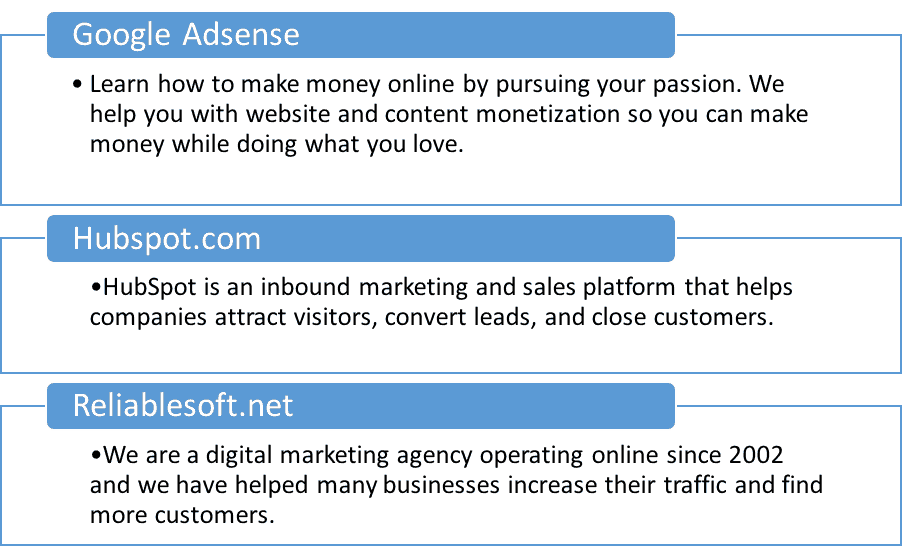
10. Optimize your images and other media elements
Images, graphs, infographics, videos, statistics, and other media elements, make a blog post more interesting to read and enhance the quality of the content.
Although Google has made it clear that they cannot yet understand the context of an image or video (while crawling a page), yet many webmasters fail to follow the rules of making their images SEO optimized.
All it takes is to use meaningful file names and a human-friendly ALT TEXT.

For example, if you are publishing an image that shows the SEO statistics for 2020 don’t name the image as img001.jpg but rename it to something more meaningful i.e. seo-statistics-2021.jpg.
For the ALT TEXT, don’t leave it blank but write a few words that describe the image i.e. SEO Statistics 2020.
Hint: The ALT Text of an image is another opportunity to use related keywords in your blog post.
Bonus Tip: Keep your content up-to-date
A lot of people are asking in various forums “How often should I update my blog?” and “Is content freshness a ranking factor?”, and I can understand the reason.
It would be great if someone told you that you don’t have to update your blog regularly, that would make things a lot easier for all of us but unfortunately, that’s not the case.
You need to have fresh content on your blog for a number of reasons.
- It will increase the number of pages you have in the Google index. This makes your website and domain stronger.
- It’s another incentive for users to come back to your blog.
- It’s a great ‘excuse’ to get in touch with your subscribers.
- It’s one of the ways to stay in synch or bypass your competitors.
- It will help you improve your writing skills
- It can generate more page views

Conclusion
The takeaway lesson from this blog post is the following:
Before starting a new post, spend some time doing your research and have clear in your mind what to write about and what you want to achieve.
Follow the guidelines explained above to write SEO-friendly blog posts and if you have existing blog posts that are not optimized, allocate some time to go back and make the necessary changes.
Come up with a publishing schedule that you can follow and stick to it for a long time.
If you started learning SEO, don’t lose your hope, results in the first months may not be so good but keep publishing high-quality optimized content and the traffic will eventually flow in.





Hi Alex,
I will definitely follow this process. This is worth more than a thousand dollar knowledge and experience.
Jaime
Hi Jaime
Good luck with your blog post optimization process!
Thanks
Alex
Last night I was looking for something about how can i make a proper post? When I arrived to this site but I didn’t find anything about this issue and then went looking for other sites But, this afternoon, when I opened my browser, I get this message (push notification). I was so glad to this post, exactly what I was looking for, with the right images that are used in the text
Thank you so much
Thanks Alex for sharing great post once again SEO friendly blog post it’s really necessary part of the blog post and definitely its really helpful for my future blog post.
Hi Narinder
Thanks for your nice comment.
Alex
Thanks Alex you really know your onions, some really good stuff here…
Hi Walter
Thanks a lot. Good luck with your blog writing process.
Thanks
Alex
Hey Alex!
Thanks for sharing an all-inclusive checklist to stick to for strategies to work around. I would love to read more such content.
Hello Alex,
Crafting a blog post is an art and practicing will make it more attractive. Creating a optimized blog post can help you get quality readers and also increase the authority of your blog. Thanks for writing this beautiful and informative post. Its really very helpful.
Great Post Alex, I think you have covered pretty much everything a new blogger would need to be SEO friendly. I wish content like this was available back in the day when i started. I had to learn everything by experience and testing new stuff.
Hey Alex,
Awesome stuff! This is a great post for optimizing a blog post. Will surely follow this process in my next blog. Thanks for sharing.
Such a knowledgeable post-Mr. Alex it’s almost covering all the SEO Tips, Thanks Again.
This is very informative post !you explain here how to make fully SEO optimized blog post which is drive traffic to our site .
Hey, This is an informative and valuable article to read. Thanks for sharing it. I totally learned to write an SEO friendly post for my blog.
Hey Alex,
Great post. I’ll definitely follow these process. thanks for giving such useful and informative content. Its great to read this.
Thank you for sharing.
Maria.
I just love the way you explained the points . Even a complete newbie shouldn’t find it difficult implementing these SEO strategies. I am glad I stumbled on this. Thanks for sharing
Hi,
It’s a nice article. Your point on “to avoid keyword stuffing and repeating the same keyword over and over again…” was new to me.
I know the post should be search engine friendly and at the same time reader friendly. It’s a tough task to balance both and your tips to avoid keyword stuffing is good at this point.
Thanks.
Amazing post and well written. I learn new things about seo friendly article writing. Thanks for sharing and keep it up!
Hey alex, This is an informative and valuable article for me. Thanks for sharing this. I totally learned to write an SEO friendly post for my blog.
Great post, the post you have put together with so much information is awesome and I like the way you communicate with readers. I hope to learn more from you.
Exactly what I was looking for to share with a client. Very detailed – I always try to explain all these when in meetings I think I might just print it and bring it with me! Kuddos. I particularly like how not everything is about SEO but you included the human element – for instance short paragraphs it just makes sense – to break down content in easily digestible snippets.
Hello Alex,
I really like the way you have structured your article. You have perfectly defined all the points about “how should write the seo friendly blogs?” which will be useful for bloggers and readers.
Thank you for your efforts.
Hello Alex ,
Thanks for providing such a informative article…
I hope so, this article helps me to increase my website ranking ranking. i will definitely implement this strategies on my website.
Thanks Again…
Kapil Heera
hey thanks for such Great post about SEO friendly blog post. its help to me also to use this type of strategies on my blog to boost my seo ranking as google like my post.
thanks
Fantastic write up.. however it may need an update. I just watched a video by Google, they say that up to 5 H1 are ok on a single page. But structure is important for sure. Thanks for this.
Thanks a lot for the guide to write a complete seo content
This article is really helpful when it comes to blog conversion which will get higher traffic ranking.
Hi Alex
Thanks for sharing this information. This is very helpful for me
I’m really impressed after reading this post. You exactly explained what Google crawlers and readers love to read
Hi Mitchelle
Thanks for your nice comment.
Alex
Good article. I have read that using a keyword in the tag is helpful for the ranking of a website. Is this true, should I try it for my website?
Hi Alex,
I have been in the seo industry for many years, but this is the most comprehensive guides I have come across and have shared this with my staff.
SEO is important. True, one should write meaningful paragraphs. Thanks for sharing this article with us.
Nice tips and easy to understand. Keep sharing awesome content.
I’m really impressed after reading this post. You exactly explained what Google crawlers and readers love to read
Thank you so much sharing wonderful post with us.Its very useful for me now to write a seo friendly post.
A well written and optimized content can rank well on Google without getting too many backlinks. Thanks for sharing these useful guide!
Nice tips, these are very helpful for improving blog quality and make optimized blog. Thanks for Sharing, this helps a lot.
I’m really impressed after reading this post. You exactly explained what Google crawlers and readers love to read you can name this SEO checklist
Nice article . It is easy and simple to understand the concept of SEO.
Thanks a lot!
I have read out a numbers of website but could not get complete information
only and only this website is complete how to write a proper blog post.
nice trick I have tried this and it works amazing.
Hello alex
This is definitely a great article to write blogs. As a Newbie like me, we faced those problems that you discussed but i got confidence that i will be able to solve those problems during my blog post!!
Many many thanks again
Great!
This is a very informative post! you share the most concise guide to SEO friendly blog posts.
Thanks for sharing!
Great!
This is a very informative post! you share the most concise guide to SEO friendly blog posts.
Thanks for sharing!
This article was very helpful! So much information to absorb, I had to come back and take 2 pages of notes so I can start using these methods myself! Thank you for the tips.
Thank you so much for sharing this post. I have learned a handful of tips to put into my blogging journey. I am still trying to figure out what keywords would be best, but I feel like I have a better idea of what direction I am going now. Thanks again.
Hi Sarah
Good luck with your blogging journey!
Alex
This is one of the best posts I’ve read. The information provided is very useful. This article has helped increase my blog’s ranking. Allow me to share this article.
Thanks for sharing – How to Write SEO Friendly Blog Posts. This blog post is very helpful for me and others. Thanks again for writing a nice post.
Thanks for sharing such a very informative blog about how to write SEO friendly blog, if we want to rank our blog then we need to write an SEO friendly blog so your post is really helpful for me and I want to say your way of explanation and writing is very easy and understandable, I liked so much and thank you very much for sharing this step by step guide
Keep posting and have a nice dai!
Learning online saves much time well your blog was pretty interesting and helpful 🙂
I really appreciate your work 🙂
Hi Priya
Thanks a lot!
Alex
Hai, Alex
I’m just new in Blogging world and i learned lots of things of Blogging. And this post will help me larned more about Seo .And build lot more confidence in Blogging. I just bookmark your post so that i read more times and make things clear!
This is very informative and useful blog article. I also love writing, and making some blogs, and this article is really interesting. Thank you for sharing your knowledge on how to write SEO Friendly Blog Posts. This blog article provides the best tips that a writer could ever see. Keep up the good work.
Hi Gee
Thanks a lot for your comment. Glad I could help you learn how to write SEO optimized blogs.
All the best
Alex
Hi Alex
Thanks for sharing such an informative post. I am pretty sure that I can utilize these strategies for my SEO company. Expect more from you in the future.
Keep it up.
Thanks.
It is a good article with lots of useful insights. Especially I liked your ‘Craft the title and URL’ section where you discussed and gave tips on how to select an SEO friendly title. Thank you very much for writing this amazing post.
Hi, tnx for post. Question about meta: Google does sometimes use their own meta or not? Am I doing something wrong?
Hi
Please read this: https://www.reliablesoft.net/meta-keywords/ -> it has all the details about meta and what Google and other search engines are using.
Thanks
Hi, ALEX CHRIS , tnx for this content. It is very helpful to me . Again thanks for your bonus tips. I am hopeful to get more content.
On page SEO is really important. It shouldn’t be taken for granted. Getting a website to be on top of search results is really challenging but it is worth it.
Great content! I was starting my blog and this really gave a good start on my first post I am going to publish!
Would like to hear from you other recommended advice for the blogging starter like me!
Thank you very much for SEO on blogger tips
Thanks! This is a well-written article. Normally, I don’t post comments on any sites…but here I had to. Bookmarking this and enrolling to your course 🙂
Thanks Alex for these great tips. They were very helpful to help me improve with SEO on my sites. I have heard a lot about Semrush, but I think I will definitely start using this keyword tool.
Hi, This is a real, eye-opening info for me too. I’ve been struggling to get some of my best contents to ranked high, felt like I’d done everything I could.
I’ve read this article of yours twice now and am going to apply as much as I can. Thank you for sharing your advice!
I’m new to blogging. This article is real eye opener for me. M learning about SEO, I find the article very interesting and informative. M sure this info will help me to improve my blog SEO. Thanks for amazing tips.
Wow this was very beneficial Alex, thank you so much will share this with our clients that do Blog writing
Hi Yasmin
Thanks a lot!
Alex
Nice article, i will definitely apply these steps on my digital marketing site. Thanks again. 👍
Hi Souvik
Thanks for commenting. Yes, applying these steps to all your blogs will definitely help your site.
All the best
Alex
its really an awesome piece of an article, and now I’m using images on my article.
Thanks 🙂
Hi Olid
Thanks for your comment!
Alex
The meta description tag serves the function of advertising copy. It draws readers to a website from the SERP, and thus is a very visible and important part of search marketing. I’m glad that I came across this amazing article! Thanks for posting such an important piece of content.
Hi Alex,
This is a very informative article about SEO friendly blog post I have ever read . I have deeply understood the concept and will keep trying my best.
Thanks
From relevant keywords to links from other websites, there are several ways to optimize your website for SEO success. Great article you have shared here.
Thanks for sharing such a great article, it covers all the necessary tips which help us how we write an SEO-friendly blog post and explained the importance of optimization of the title for SEO.
Kudos to this blog. It gives me more knowledge on how to post a blog.I hope you will create more articles just like this. Thank you for the crucial steps.
Great content, but spelling error on this paragraph, “Don’t just through large paragraphs on a page and hit the publish button.” Should be “throw.”
Hi Gilda
Thanks a lot for catching that error.
All the best
Alex
I learned a lot about SEO from your post great work. Thanks a lot
Thanks..Really an informative blog post. I will check all my old post and start changing them for good SEO ranking.
Thanks for such a detailed and step-by-step guide. Writing content optimized for search and conversion is an art.
Seriously! A great post for beginners looking to learn more about SEO and content. Thanks a lot for this beautiful piece of information.
Thank you for the amazing post. The complete guidance of SEO results in google search. The content is wonderful to read its easily understand to every users.
Awesome article Alex! This was very informative and super helpful for beginners! Definitely something that we all can improve with for content. This is really nice guide to learn SEO friendly blog posts.
Thanks for sharing!
Great information about SEO I got great results from these tips. thanks a lot please keep it up…
A great post for beginners who want to learn more about SEO and content. thanks for sharing